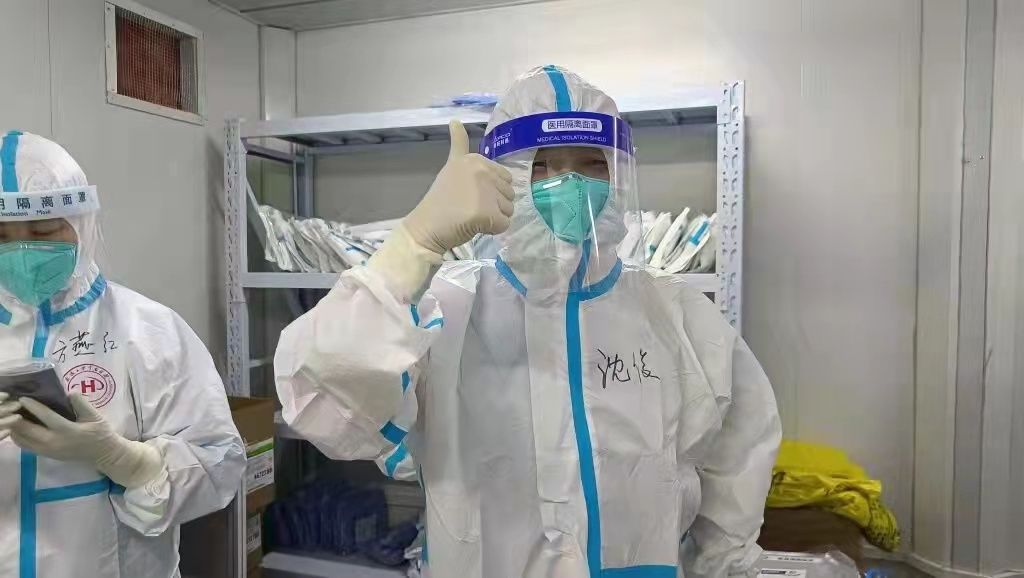“When the epidemic in Wuhan was the worst, many medical teams from Shanghai came to help. Our Zhongnan Hospital also received their assistance. Now that such a situation occurs in Shanghai, we are also obliged to help them.” 44 years old The doctor Shen Jun said.
He is an emergency doctor and deputy director of the Health Insurance Department of Zhongnan Hospital of Wuhan University, and is also the deputy leader of the medical team in Shanghai this time. They will be responsible for the medical work of the Fangcang shelter hospital.
On the fourth day after arriving in Shanghai, Shen Jun entered the makeshift hospital and saw that the patients were in an orderly manner, and they were no longer too panicked and afraid as at the beginning of the epidemic. Their work goal is also to pay attention to the psychological state of patients, and to identify early severe patients from mild patients, and transfer them to designated hospitals for treatment in a timely manner. Shen Jun said that there are not many such patients.
According to the release of Shanghai, from 0 to 24:00 on April 5, 2022, 311 new local confirmed cases of new coronary pneumonia and 16,766 asymptomatic infections were added in Shanghai, of which 40 confirmed cases were previously asymptomatic infections 4 confirmed cases and 16,256 asymptomatic infections were found in isolation and control, and the rest were found in the investigation of relevant risk groups.
Shen Jun believes that under such circumstances, it is necessary to establish a Fangcang shelter hospital to isolate patients with mild symptoms, so as to avoid more spread and return to normal life as soon as possible. It can also relieve the pressure on local hospitals for the treatment of routine diseases.

The following is the story of Shen Jun.
I entered the makeshift hospital to inspect in advance, familiarize myself with the environment, and arrange the distribution of personnel and materials.
This was originally the New International Expo Center, but now it is divided into five or six cabins, and a single cabin can accommodate more than 1,000 patients. The cabin we are in charge of is almost full now, and all of them are mildly ill. There is an open-air activity area in the hospital, where patients can bask in the sun in an orderly manner, unlike at the beginning of the epidemic, when everyone was very flustered and scared.
Our hospital’s Shanghai medical team consists of 10 doctors, 40 nurses, and a hospital infection control staff member. The team members have basically experienced the Wuhan epidemic and know what is going on. For patients with mild symptoms, the main focus of work is not medical treatment, but psychological counseling and reassurance for patients, as well as early identification of moderate and severe patients from mild patients, and timely transfer to designated hospitals for treatment.
The outbreak in Shanghai is different from that in Wuhan in 2020. The virus is highly contagious, but it is serious and has a low mortality rate. Therefore, I think it is very necessary to establish a Fangcang shelter hospital and isolate patients with mild symptoms in a centralized manner, so as to avoid more spread and return to normal life and work as soon as possible. It can also relieve the pressure on local hospitals for the treatment of routine diseases.
I am a doctor in the emergency department of Zhongnan Hospital of Wuhan University and the deputy director of the cadre health care department. This time, the hospital will set up a medical team to assist Shanghai, and priority will be given to those who have participated in the anti-epidemic and have work experience in Fangcang shelter hospitals. The leaders arranged for me to be the deputy team leader to assist Vice President Li Zhiqiang in his work.
In early 2020, when the epidemic in Wuhan was the worst, our hospital was a designated hospital. I have been working in the EICU since the beginning, and all the critically ill patients were treated until the epidemic situation was fully controlled and improved. As a window of the hospital, the emergency department needed to be re-examined. Work.
At the time of the worst epidemic in Wuhan, we received help from many medical teams from Shanghai, and our Zhongnan Hospital also received their assistance. Now that such a situation occurs in Shanghai, we are also obliged to help A handful of them.
On the way to the Fangcang shelter hospital today, there was no one or a car. On the first day after the Qingming Festival, it was originally a time of heavy traffic and people, but now it is so deserted. Seeing these will remind you of Wuhan in 2020.
I hope the epidemic will end soon, and Shanghai will return to its former vibrant and busy scene as soon as possible.
Come on, Shanghai.
Jiu Pai News Reporter Wang Jiaqing